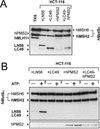N-terminus of hMLH1 confers interaction of hMutLalpha and hMutLbeta with hMutSalpha
- PMID: 12799449
- PMCID: PMC162253
- DOI: 10.1093/nar/gkg420
N-terminus of hMLH1 confers interaction of hMutLalpha and hMutLbeta with hMutSalpha
Abstract
Mismatch repair is a highly conserved system that ensures replication fidelity by repairing mispairs after DNA synthesis. In humans, the two protein heterodimers hMutSalpha (hMSH2-hMSH6) and hMutLalpha (hMLH1-hPMS2) constitute the centre of the repair reaction. After recognising a DNA replication error, hMutSalpha recruits hMutLalpha, which then is thought to transduce the repair signal to the excision machinery. We have expressed an ATPase mutant of hMutLalpha as well as its individual subunits hMLH1 and hPMS2 and fragments of hMLH1, followed by examination of their interaction properties with hMutSalpha using a novel interaction assay. We show that, although the interaction requires ATP, hMutLalpha does not need to hydrolyse this nucleotide to join hMutSalpha on DNA, suggesting that ATP hydrolysis by hMutLalpha happens downstream of complex formation. The analysis of the individual subunits of hMutLalpha demonstrated that the hMutSalpha-hMutLalpha interaction is predominantly conferred by hMLH1. Further experiments revealed that only the N-terminus of hMLH1 confers this interaction. In contrast, only the C-terminus stabilised and co-immunoprecipitated hPMS2 when both proteins were co-expressed in 293T cells, indicating that dimerisation and stabilisation are mediated by the C-terminal part of hMLH1. We also examined another human homologue of bacterial MutL, hMutLbeta (hMLH1-hPMS1). We show that hMutLbeta interacts as efficiently with hMutSalpha as hMutLalpha, and that it predominantly binds to hMutSalpha via hMLH1 as well.
Figures











Similar articles
-
hMutSalpha forms an ATP-dependent complex with hMutLalpha and hMutLbeta on DNA.Nucleic Acids Res. 2002 Feb 1;30(3):711-8. doi: 10.1093/nar/30.3.711. Nucleic Acids Res. 2002. PMID: 11809883 Free PMC article.
-
Mutations within the hMLH1 and hPMS2 subunits of the human MutLalpha mismatch repair factor affect its ATPase activity, but not its ability to interact with hMutSalpha.J Biol Chem. 2002 Jun 14;277(24):21810-20. doi: 10.1074/jbc.M108787200. Epub 2002 Apr 10. J Biol Chem. 2002. PMID: 11948175
-
Identification of hMutLbeta, a heterodimer of hMLH1 and hPMS1.J Biol Chem. 1999 Nov 5;274(45):32368-75. doi: 10.1074/jbc.274.45.32368. J Biol Chem. 1999. PMID: 10542278
-
Molecular basis of HNPCC: mutations of MMR genes.Hum Mutat. 1997;10(2):89-99. doi: 10.1002/(SICI)1098-1004(1997)10:2<89::AID-HUMU1>3.0.CO;2-H. Hum Mutat. 1997. PMID: 9259192 Review.
-
Structural, molecular and cellular functions of MSH2 and MSH6 during DNA mismatch repair, damage signaling and other noncanonical activities.Mutat Res. 2013 Mar-Apr;743-744:53-66. doi: 10.1016/j.mrfmmm.2012.12.008. Epub 2013 Feb 4. Mutat Res. 2013. PMID: 23391514 Free PMC article. Review.
Cited by
-
Human MutL homolog (MLH1) function in DNA mismatch repair: a prospective screen for missense mutations in the ATPase domain.Nucleic Acids Res. 2004 Oct 8;32(18):5321-38. doi: 10.1093/nar/gkh855. Print 2004. Nucleic Acids Res. 2004. PMID: 15475387 Free PMC article.
-
Identification of MLH2/hPMS1 dominant mutations that prevent DNA mismatch repair function.Commun Biol. 2020 Dec 10;3(1):751. doi: 10.1038/s42003-020-01481-4. Commun Biol. 2020. PMID: 33303966 Free PMC article.
-
Therapeutic targeting of mismatch repair-deficient cancers.Nat Rev Clin Oncol. 2025 Jul 10. doi: 10.1038/s41571-025-01054-6. Online ahead of print. Nat Rev Clin Oncol. 2025. PMID: 40640471 Review.
-
C-terminal fluorescent labeling impairs functionality of DNA mismatch repair proteins.PLoS One. 2012;7(2):e31863. doi: 10.1371/journal.pone.0031863. Epub 2012 Feb 14. PLoS One. 2012. PMID: 22348133 Free PMC article.
-
NPM-ALK mediates phosphorylation of MSH2 at tyrosine 238, creating a functional deficiency in MSH2 and the loss of mismatch repair.Blood Cancer J. 2015 May 15;5(5):e311. doi: 10.1038/bcj.2015.35. Blood Cancer J. 2015. PMID: 25978431 Free PMC article.
References
-
- Marti T.M., Kunz,C. and Fleck,O. (2002) DNA mismatch repair and mutation avoidance pathways. J. Cell. Physiol., 191, 28–41. - PubMed
-
- Modrich P. (1997) Strand-specific mismatch repair in mammalian cells. J. Biol. Chem., 272, 24727–24730. - PubMed
-
- Peltomaki P. (2001) DNA mismatch repair and cancer. Mutat. Res., 488, 77–85. - PubMed
-
- Lynch H.T. (1999) Hereditary nonpolyposis colorectal cancer (HNPCC). Cytogenet. Cell Genet., 86, 130–135. - PubMed
Publication types
MeSH terms
Substances
LinkOut - more resources
Full Text Sources
Other Literature Sources
Research Materials

